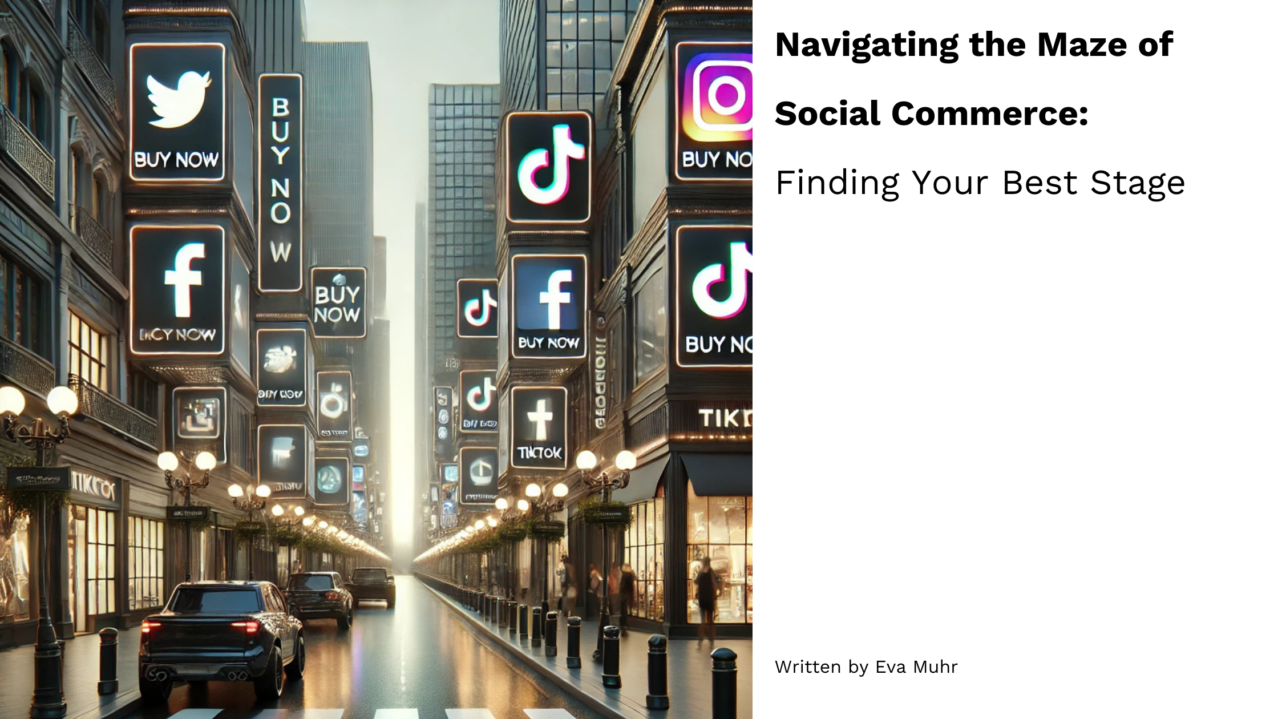Navigating the Maze of Social Commerce: Finding Your Best Stage
Over the past few years, social commerce has piqued the interest of both our media owner and brand-side clients, and as a result, we’ve seen more and more briefs coming our way on the topic.
That’s because in today’s fast-paced digital marketplace, over 70% of shoppers begin their product discovery on social media. That’s right – almost everyone finds new products just by scrolling through their feeds!
The Platform Story: Different Stages, Same Play
Imagine social commerce platforms as different types of retail spaces, each with its own atmosphere and audience expectations.
The Digital High Street: Facebook and Instagram
Facebook and Instagram are today’s version of a bustling high street, where people naturally browse and discover, as part of their daily routines. Think of it like strolling through a busy shopping centre, only instead of window displays, it’s your feed that catches their eye. These platforms turn casual scrolling into effortless shopping, blending discovery and convenience in a way that feels intuitive.
Take Revolve, for example. The popular ‘hot girl’ clothing platform, generates FOMO through influencer-driven content-like destination events such as Revolve Festival, and shoppable feeds, leading to a 2.66% follower growth rate.
But here’s the key: most of this happens on mobile. That’s why a mobile-first design is absolutely essential. Imagine walking into a store and finding cluttered, badly signed-posted aisles—it’s infuriating, right? The same goes for social commerce. A seamless, responsive mobile experience ensures a smooth journey for your customers, keeping them engaged and ready to take action.
The Entertainment District: TikTok and YouTube
Step into TikTok and YouTube, and you enter an entertainment-driven shopping experience – part live shopping channel, part digital stage for peer-to-peer or micro-influencers. Here, commerce blends seamlessly with entertainment, where successful brands don’t just sell, they perform. YouTube’s shopping feature integrates with Shopify, enabling merchants to create product listings that appear in their videos and on the YouTube Shopping tab. Take LEGO, for example, a brand with 19.5 million subscribers and 13.62 billion views, presenting a powerful opportunity for growth.
Chipotle has built a 2M-strong TikTok following through dance challenges like the #GuacDance and behind-the-scenes kitchen content, merging trends with authenticity. Product demonstrations become engaging mini-shows, making shopping a natural part of the experience rather than its focus.
The Innovation Quarter: Snapchat and Pinterest
Venture into Snapchat and Pinterest, and you’ll find yourself in a space where traditional boundaries blur. These platforms provide futuristic, immersive shopping experiences with virtual try-ons and visual discovery tools.
Carhartt, leveraged AR with ‘Portal Lenses’ for virtual beanie try-ons and a gamified gardening experience, driving an +11-point lift in brand awareness and +14-point lift in purchase intent. Meanwhile, ASOS, expresses its brand personality on Pinterest through organic, fashion-focused content and Shopping Pins, allowing for seamless product purchases without a hard-sell approach.
The Universal Truth: Your Audience Leads the Way
No matter which stage you choose, remember that an exceptional user experience is one that’s accessible to everyone. Implementing inclusive design principles, such as clear typography, adequate contrast, and navigability through assistive technologies, ensures that your brand resonates with a broader audience. Not only does this foster trust and loyalty, but it also positions your brand as a forward-thinking leader in social commerce.
Finding Your Stage
The key questions remain consistent across all platforms:
- Where does your audience naturally spend their time?
- How do they prefer to interact with content?
- What type of shopping experience matches their expectations?
Building Your Performance
Once you’ve found your stage, success comes from:
- Understanding local customs (platform-specific behaviours and cultural insights)
- Speaking the local language (content style and tone)
- Respecting local traditions (user expectations and community norms)
- Future-proof Your Strategy
Think of your social commerce strategy as directing a play:
- Select Your Venue (platform) – Identify where your audience is most active
- Write your script (content) – Develop content that fits the platform’s style and your brand’s voice
- Direct Your Performance (customer journey) – Optimise the customer journey from discovery to conversion
The most successful brands aren’t those using every feature of every platform. Instead, they deeply understand their audience, choose the right stage, and execute flawlessly within that space.
The Bottom Line
Whether your brand finds its home in Facebook’s digital high street, TikTok’s entertainment district, or Snapchat’s innovation quarter, remember: the platforms are just stages. The real art of social commerce lies not in mastering every feature but in choosing the right stage for your brand’s unique voice—and delivering an experience that resonates with your audience.
So, where is your brand’s stage? Are you performing where your audience is already engaged, or are you chasing trends that don’t fit your strategy? The strongest brands aren’t everywhere, they’re exactly where they need to be.
To read more of our insights into social commerce, check out our IAB Compass report, where we examine emerging trends in shoppable advertising, or our 2023 Acxiom CX Trends report, which highlights the immersive shopping opportunities available to brands.
